The Eurasian Oystercatcher (Haematopus ostralegus) is a charismatic coastal bird species renowned for its striking appearance and distinctive behaviors.
Found along the shores of Europe and Asia, this wader captivates bird enthusiasts with its bold black and white plumage, long orange-red bill, and loud, melodious calls.
Known for its specialized feeding habits, the Eurasian Oystercatcher utilizes its sturdy bill to pry open shellfish such as oysters and mussels, showcasing its adaptability to intertidal habitats.
Breeding in spring and summer, these birds establish territories along the coast, where they construct shallow nests in sandy or gravelly areas.
With its fascinating life history and vital role in coastal ecosystems, the Eurasian Oystercatcher remains a subject of interest for researchers and conservationists alike. Stay sharp.
Physical Characteristics of Eurasian Oystercatcher
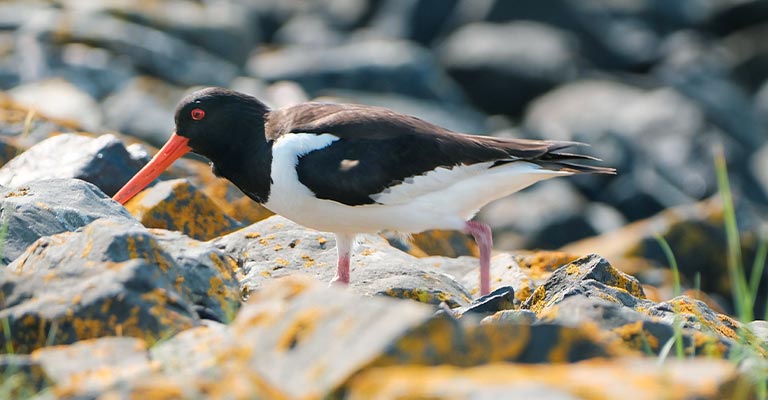
The Eurasian Oystercatcher (Haematopus ostralegus) is a distinctive bird species belonging to the Haematopodidae family, characterized by its striking physical features and behavior.
Identifying this bird requires attention to detail and an understanding of its key characteristics. Here are some of the key points to aid in the identification of the Eurasian Oystercatcher:
Size and Shape
Eurasian Oystercatchers are medium to large-sized waders, typically measuring around 40-45 centimeters in length.
They possess a robust body with long legs and a stout, slightly down-curved orange-red bill, perfectly adapted for prying open shellfish.
Plumage
The plumage of Eurasian Oystercatchers is predominantly black on the upper parts, including the head, wings, and back, contrasting sharply with their white underparts.
A distinctive black and white pattern extends from the face, wrapping around the neck and onto the breast, resembling a black bib or necklace. This feature is particularly prominent during the breeding season.
Legs and Feet

Their legs are long and sturdy, ranging from pinkish to reddish-orange in color. The coloration of the legs becomes more intense during the breeding season, serving as a visual signal during courtship displays.
Eurasian Oystercatchers have webbed feet, ideal for foraging along coastal areas and mudflats.
Bill Color and Shape
The bill of the Eurasian Oystercatcher is a distinctive feature, being long, straight, and tapered towards the tip.
It is orange-red in color with a slight downward curve, making it well-suited for prying open mollusk shells, their primary food source.
Voice
Eurasian Oystercatchers are known for their loud, piping calls, often described as a shrill “kleep” or “kleep-kleep.” These vocalizations are frequently heard during territorial disputes or when communicating with mates and offspring.
Habitat
These birds are commonly found in coastal habitats such as sandy beaches, mudflats, salt marshes, estuaries, and rocky shorelines.
They prefer areas with easy access to their primary food source, bivalve mollusks like oysters, mussels, and clams.
Behavior
Eurasian Oystercatchers are highly active birds, often observed probing the sand or mud with their bills in search of prey.
They are known for their distinctive feeding technique, hammering or stabbing at mollusk shells to access the soft flesh inside.
Distribution
As their name suggests, Eurasian Oystercatchers are widely distributed across Europe and Asia, with populations extending into parts of North Africa.
They are migratory birds, with some populations undertaking long-distance migrations to wintering grounds in southern Europe and Africa.
Identifying the Eurasian Oystercatcher requires careful observation of its physical characteristics, including size, plumage, bill shape, and coloration.
Additionally, understanding its habitat preferences, behavior, and vocalizations can further aid in accurate identification, making it a fascinating species for bird enthusiasts and conservationists alike.
Taxonomy of Eurasian Oystercatcher
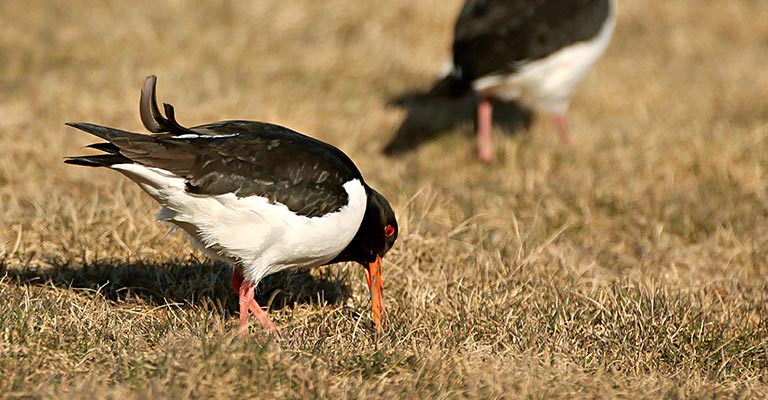
Here’s a cool and informative table outlining the taxonomy details of Eurasian Oystercatcher:
| Domain | Eukaryota |
| Kingdom | Animalia |
| Phylum | Chordata |
| Class | Aves |
| Order | Charadriiformes |
| Suborder | Charadrii |
| Family | Haematopodidae Bonaparte, 1838 |
| Genus | Haematopus |
| Species | H. ostralegus |
The Eurasian Oystercatcher (Haematopus ostralegus) exhibits remarkable diversity across its four recognized subspecies, each adapted to specific geographical regions and migratory routes:
- H. o. outrageous: This subspecies breeds in Iceland, Scandinavia, and South Europe before migrating to wintering grounds in West Africa. Its migratory journey takes it across vast distances, highlighting its endurance and navigational skills.
- H. o. Longines: Breeding from Ukraine and Turkey to central Russia and west Siberia, this subspecies undertakes a migration to east Africa for the winter months. Their journey involves traversing diverse landscapes, from temperate forests to open grasslands, reflecting their adaptability to varied habitats.
- H. o. buturlini: Found breeding in west Kazakhstan to northwest China, these oystercatchers migrate to wintering grounds in southwest Asia and India. Their migration route intersects with numerous ecological zones, demonstrating their ability to thrive in different environments.
- H. o. osculans: Breeding in the Kamchatka Peninsula, Korean Peninsula, and northeast China, this subspecies winters in east China. Their migration involves navigating across rugged terrain and encountering diverse climatic conditions, showcasing their resilience in the face of environmental challenges.
The diverse distribution and migratory patterns of these subspecies underscore the adaptability and ecological significance of the Eurasian Oystercatcher across its range.
Studying these variations provides valuable insights into avian evolution, habitat preferences, and conservation needs.
Hunting Habit of Eurasian Oystercatcher
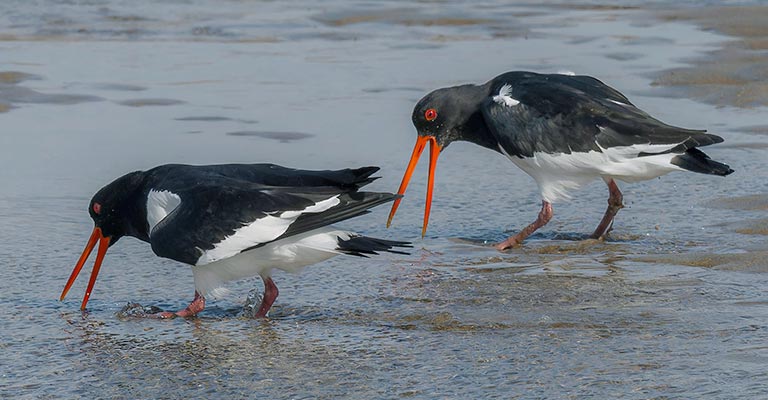
The Eurasian Oystercatcher is a skilled hunter, primarily feeding on bivalve mollusks such as oysters, mussels, and clams. With its long, sturdy bill, it probes the sand or mudflats along coastal areas, searching for buried prey.
When it detects a shellfish, the oystercatcher uses its bill to pry open the shell, hammering or stabbing with precision to access the soft flesh inside.
This feeding technique requires strength and dexterity, which the oystercatcher possesses in abundance. It is also known to feed on other small invertebrates and occasionally on fish or crustaceans.
Their hunting habit is characterized by relentless probing and striking, demonstrating their adaptability to forage efficiently in intertidal zones and coastal habitats, making them a vital component of these ecosystems.
Eurasian Oystercatcher Life History
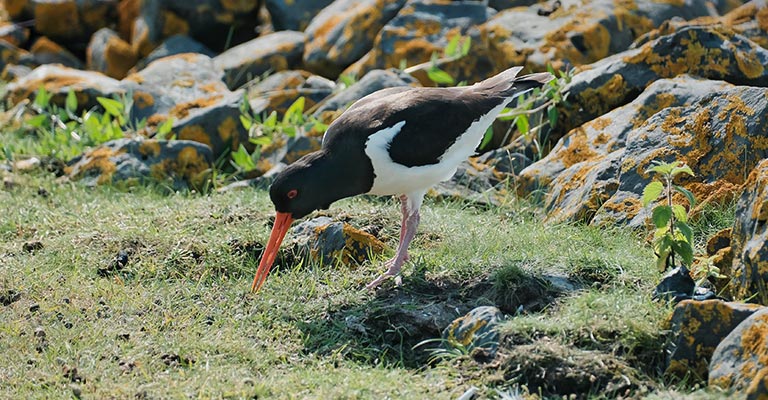
The Eurasian Oystercatcher (Haematopus ostralegus) is a charismatic bird species found along coastal regions of Europe and Asia.
Renowned for its striking appearance and distinctive call, this wader plays a crucial role in coastal ecosystems. Understanding its life history provides insights into its ecology and conservation needs.
Food
Eurasian Oystercatchers primarily feed on bivalve mollusks like oysters, mussels, and clams, utilizing their specialized bill to pry open shells. They also consume small invertebrates, fish, and crustaceans found in coastal habitats.
Habitat
These birds inhabit a variety of coastal environments, including sandy beaches, mudflats, salt marshes, estuaries, and rocky shorelines. They require access to intertidal areas rich in shellfish for foraging.
Range Map
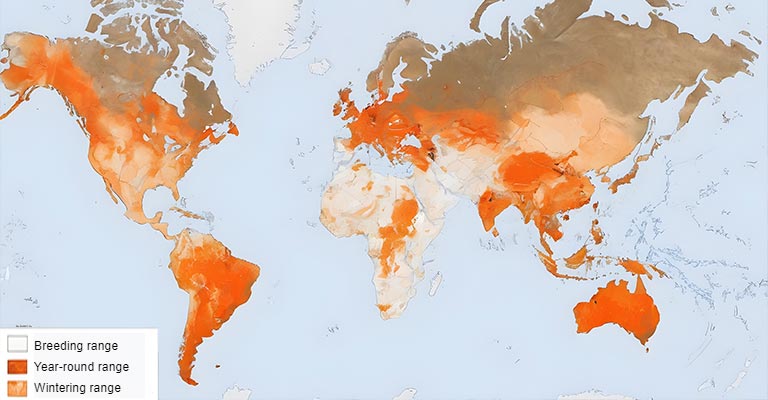
Eurasian Oystercatchers have a wide distribution across Europe and Asia, with breeding populations extending from the British Isles to eastern Russia. Their range also includes parts of North Africa and the Middle East.
Breeding
Breeding occurs in spring and summer, with pairs establishing territories along the coast. Nests are typically shallow scrapes in sandy or gravelly areas.
Females lay 2-4 eggs, and both parents share incubation duties. Chicks hatch after about 4 weeks and are precocial, leaving the nest shortly after hatching.
Diseases
Eurasian Oystercatchers can be susceptible to avian diseases such as avian influenza and avian botulism, particularly in areas with high population densities and environmental stressors.
Treatment
Treatment for avian diseases typically involves monitoring and surveillance programs to detect outbreaks early. Measures such as habitat management and reducing human disturbance can also help minimize disease transmission.
Conservation
Conservation efforts for Eurasian Oystercatchers focus on habitat protection, including the preservation of intertidal feeding areas and nesting sites. Additionally, managing human activities such as coastal development and recreational disturbance is essential for their long-term survival.
Monitoring population trends and implementing sustainable fishing practices also contribute to conservation efforts for this iconic coastal species.
The life history of the Eurasian Oystercatcher encompasses its feeding habits, habitat preferences, breeding behavior, disease risks, treatment options, and conservation needs.
By understanding and addressing these aspects, we can work towards ensuring the continued survival of this vital component of coastal ecosystems.
Nesting Habit of Eurasian Oystercatcher
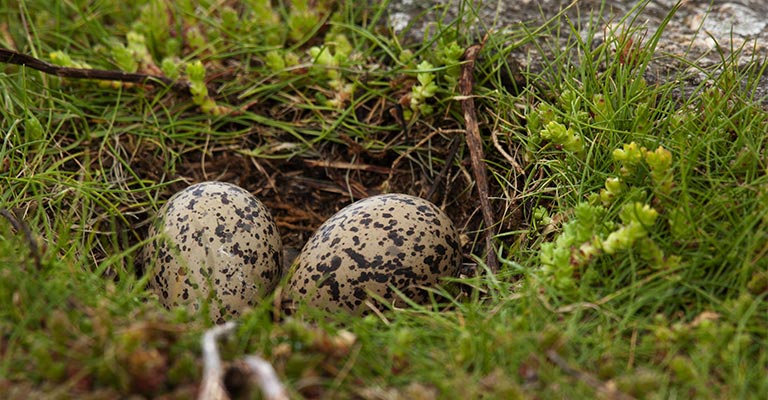
Check out the table below outlining the nesting details of the Eurasian Oystercatcher:
| Nesting Details | Facts |
| Clutch Size | 2-4 eggs |
| Number of Broods | Usually 1 |
| Egg Length | Approximately 6.5 cm |
| Egg Width | Approximately 4.5 cm |
| Incubation Period | Around 24-28 days |
| Nestling Period | 5-6 weeks |
| Egg Description | Pale brown or buff with dark blotches or speckles |
| Nest Site | Shallow scrape in sandy or gravelly areas along the coast |
| Nest Material | Often unlined, occasionally lined with pebbles or shells |
| Incubation Behavior | Both parents share incubation duties, taking turns |
| Nest Defense | Aggressively defend nest site against intruders |
These details provide insights into the reproductive biology and nesting behavior of the Eurasian Oystercatcher, highlighting its adaptations for breeding success in coastal environments.
The Eurasian Oystercatcher typically nests in shallow scrapes on sandy or gravelly areas along the coast. Their nests are minimally lined, occasionally with pebbles or shells.
Females lay 2-4 pale brown or buff-colored eggs with dark blotches or speckles. Both parents share incubation duties, taking turns to keep the eggs warm for about 24-28 days.
After hatching, the chicks remain in the nest for a short period before becoming precocial and leaving to forage with their parents.
Throughout the nesting period, oystercatchers aggressively defend their nest site against intruders, ensuring the safety of their offspring.
5 Fun Facts About Eurasian Oystercatchers
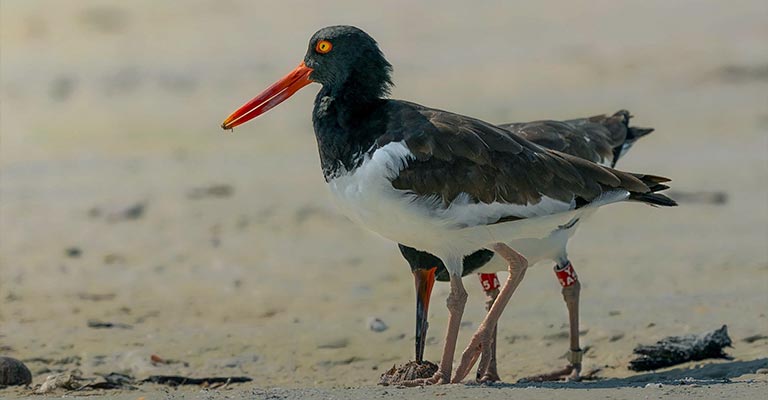
The Eurasian Oystercatcher is a fascinating bird species found along coastal regions of Europe and Asia. Here are five fun facts about these charismatic waders:
Distinctive Vocalizations
Eurasian Oystercatchers are known for their loud and melodious piping calls, which they use for communication and territorial defense.
Their calls often sound like a shrill “kleep” or “kleep-kleep,” adding to the ambiance of coastal habitats.
Long-Lived Birds
Despite facing various challenges in their environment, Eurasian Oystercatchers can live for several decades. Some individuals have been known to reach the age of 30 years or more, showcasing their resilience and adaptability.
Migratory Behavior
Many Eurasian Oystercatcher populations undertake long-distance migrations between their breeding and wintering grounds.
These migrations can span thousands of kilometers, highlighting the impressive navigational abilities of these birds.
Specialized Feeding Technique
Eurasian Oystercatchers have a unique feeding behavior, using their long, sturdy bills to pry open shellfish such as oysters and mussels.
They employ precise strikes and hammering motions to access their prey, showcasing their adaptability to coastal habitats.
Distinctive Plumage
With their striking black and white plumage, Eurasian Oystercatchers are easily recognizable along coastal shorelines.
The contrast between their black upperparts and white underparts, along with a prominent black bib or necklace, makes them a visually stunning sight for birdwatchers and nature enthusiasts alike.
Wrapping Up
So, the Eurasian Oystercatcher is a remarkable bird species with unique characteristics and behaviors.
From its distinctive vocalizations and long-lived nature to its specialized feeding techniques and striking plumage, this coastal wader captivates the imagination of bird enthusiasts worldwide.
Understanding its life history, nesting habits, and conservation needs is crucial for ensuring the continued survival of this iconic species in coastal ecosystems. Thank you so much.